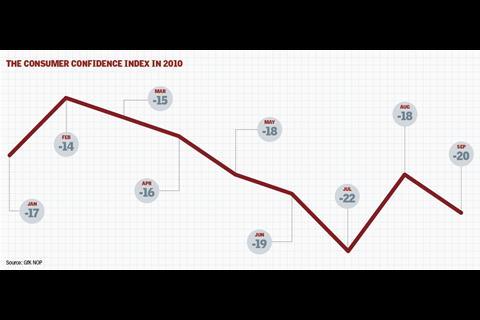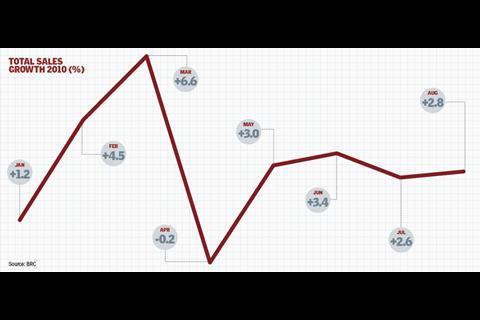Consumer confidence has fallen yet again and many expect the decline to continue - so why are sales growing, with shoppers seemingly defying their mood?
It’s the great mystery facing UK retail: if consumers are so anxious about the economic outlook, why are sales continuing to rise?
Last week consumer confidence dipped again to the second lowest point in a year, according to the respected GfK NOP index. It fell to -20 in September, after a rise in August - when the index increased for the first time since February, to -18 - which GfK NOP social research managing director Nick Moon described as a “false dawn”.
Yet in the face of this dwindling confidence, spending by UK shoppers is holding up, according to several of the most respected barometers of trade. In August, UK retail like-for-like sales rose 1%, while total sales increased 2.8%, according to the BRC-KPMG Retail Sales monitor. Across the three months to the end of August, like-for-likes went up 0.9%, while total sales increased 3%.
And the CBI Distributive Trades Survey, issued last week, reported that retail sales showed a third consecutive year-on-year increase in September, and “surpassed expectations” with the best performance for six years. Of retailers surveyed, 60% reported that the volume of sales rose during September, while only 11% said they fell, giving a balance of +49% - the highest since May 2004 (+51%), and an increase on the expected figure of +39%. The study revealed that retailers expect “another strong rise” in sales in October.
The BDO High Street Sales Tracker claimed that Britons “flocked to the high street” in August, with like-for-likes at medium-sized retailers up 3.6% during August and an average of 4.3% for the summer, making it the “most successful” on the high street for the past five years.
Paradoxical behaviour
So if shoppers are feeling less confident about their own finances and the general economy, why are they still willing to put their hands in their pockets?
Rosie Campbell, director of consumer psychology consultancy Campbell Keegan, started to notice this kind of paradoxical behaviour - where consumers say and feel one thing, but do another - between 10 and 15 years ago.
She refers to it as a “kind of perverse streak”. “It’s the ‘Because I’m Worth It’ thing,” says Campbell. “Consumers are saying, ‘I’m feeling miserable and as I’ve paid the rent on time I’m going to treat myself to a new pair of shoes.’”
The news flow about the economy in the past couple of years has been consistently negative, but Campbell explains this can drive the “need for treats”. She says Britons react more emotionally to negative news about property, as opposed to the stock market, for example.
“When consumers hear bad property news it’s more linked to their emotions - ‘how will this affect me?’” says Campbell. “This feeds the ‘sorry for myself’ sensation that makes people feel miserable. And that’s the hit to the heart that makes you go out and buy something.”
So following this argument - with the exception of home-related retailers such as furniture chains - it may not be bad news for retailers when house prices plummet and mortgage approvals drop. When miserable consumers want to treat themselves, a trip to the shops is often top of the agenda - as long as they think they are getting a bargain and believe they are ‘shopping clever’.
“There is a lot of talk about how cheaply you can get things,” says Campbell, who says if consumers view themselves as clever shoppers, it helps excuse splashing out when they know they should be saving.
This argument might help explain how the CBI data, which measures sales volumes, has seen such increases - shoppers hunting for bargains could be driving the volume growth.
And there are plenty of bargains to be had at the moment. Bhs, Debenhams and House of Fraser all launched Sales last month. And retailers such as Argos and Tesco are slashing the price of toys in an attempt to be the first to grab consumer Christmas spend.
Singer Capital Markets analyst Matthew McEachran says it is possible the “extra promotional and marketing activity” meant any sales increase was “volume led rather than margin led. This could be stimulating the extra spend.”
McEachran says that for many retailers it is promotions and Sales that are driving spend, highlighting JJB Sports, which last week said sales fell away when it took its foot off promotions.
BRC director-general Stephen Robertson believes retail sales might not be quite as robust as the BRC data is showing. Robertson argues that if retailers sold the same product this year that they did last year - when VAT was 15% - the extra VAT this year would flatter sales, even though retailers might not have sold any more of the product.
“You’re not comparing apples with apples,” says Robertson. He also says “there’s a certain degree of resilience, some due to inflation” that will “push up the apparent sales performance”.
Robertson says the 1% rise in retail like-for-like sales in August “is compared with a very poor performance a year ago” and that sales in the month were “often deal driven”.
McEachran raises questions over the validity of any sets of data. “Surveys can be misleading so you need to look at three months worth of data,” he says. He adds that none of the surveys use “all-encompassing” data, with the BRC figures only including 60% of UK retail spending. “Every month there is conflicting data,” he says.
Further falls
And retailers are finding it hard to plan as a result. One thing seems certain though: consumer confidence could fall further, especially when the Government reveals the details of its spending review on October 20.
Carpetright group commercial director Martin Harris agrees the date will be a tipping point for the UK consumer, who he describes as “petrified” about what may lie in store. Harris - who admits he is fairly confused by the conflicting data - hypothesises that the rise in sales at the moment may just be a reflection of worried consumers taking advantage of the lower rate of VAT. “They’ll be thinking: ‘If I don’t do it now I’ll have to pay the VAT come January’. So it may be the case that these sales are being brought forward,” he says.
And Harris sees consumer confidence getting worse from now on. “It will be 2012 before we see a glimmer of light. And that’s only where it reaches the bottom, not where it is restored. These are going to be tough times.”
GfK NOP (UK) business development director Ivan Browne agrees the trend for confidence is downwards. “We’ve had six months of decline in consumer confidence since February,” he says. “It then peaked in August but the trend is downwards. 57% of respondents feel the economic situation will get worse before it gets better.”
He points out that after the emergency Budget in June the index dipped. He believes that while consumers are “being prepared for being given bad news” on October 20, when the news is delivered and the “realities of paying off the debt hit home”, it is likely there will be another fall in confidence.
“The data indicates caution,” he says, although he does not envisage any further disastrous declines, and anticipates the index will “bubble along at -20 for a while unless something catastrophic happens, like a bank or retail failure”. Browne says that when Woolworths collapsed into administration in November 2008 it had a noticeable impact on consumer confidence.
So Browne is not anticipating the declines seen in 2008 when the index “fell off a cliff”, slumping from -5 to -39 in six months. He believes men are likely to maintain their spending, while women are more likely to cut back. But he adds that the “general theme is that people are cutting back so these will be very tough times from a retail perspective. Retailers will have to motivate shoppers and inspire them to dig deep and spend, so there’s a real role for retailers here”.
The fall in consumer confidence is driven by the fear of job cuts, the sluggish housing market and the rise in the cost of goods, among other things. All are likely to change in the coming months, and not in a way that will please the consumer. “There’s not a strong employment trend in the private sector and it’s worsening in the public sector,” says McEachran. “Consumer confidence will get worse - the question is how much worse.”
Facing a headwind
He says homeowners who have kept their jobs are not feeling too negative, with the rock bottom interest rates giving a “huge fillip to spending” as people are left with more money in their pockets from their mortgages and less of a willingness to save.
“But we’re now in a headwind, mortgages are more expensive and there are extra costs people are having to absorb,” says McEachran. “There are a lot of price rises but there’s no wage inflation so spending power is being eroded.”
The Asda Income Tracker corroborates this view, with family spending power decreasing 2.9% to £175 a week in August. It was the eighth consecutive month that family spending power has fallen, as the cost of living continued to rise at an elevated pace of 3.1%.
In terms of retail, price rises are coming from extra costs that store groups are facing, from cotton prices to labour costs in the Far East.
At high street bellwether Next’s update last month, chief executive Lord Wolfson said that while he did not expect a double-dip recession or a “meltdown in consumer spending” he was expecting “very little by way of growth in total consumer spending for the foreseeable future”, as consumers reacted to the Government cuts and attempted to pay off their own debt.
But while the outlook for confidence doesn’t look too promising, there are some reasons to be cheerful. Robertson points out that one index that did increase in the GfK NOP Consumer Confidence data was the ‘major purchase index’, which increased from -20 to -15 from last month, although remained flat on a year-on-year basis. Robertson believes confidence has in fact been “surprisingly resilient, bearing in mind the steady news flow of cuts that has been coming”.
And it appears that retail spending is the last thing to be cut when times get tough, according to a report conducted by retail consultancy Verdict for business analytics specialist PRGX.
Released last month, it found that although consumer confidence “will remain weak for at least the remainder of this year”, the UK consumer is “very active and engaged with the retail sector. Retail spending is likely to be prioritised over other forms of expenditure”.
Campbell agrees. “Everything seems to suggest we’ll continue shopping,” she says, calling on the saying that shopping is the average Briton’s “favourite pastime”.
“We love nothing better than a trip to the shopping centre and coming away with bags of bargains,” she adds. And although further economic challenges lie ahead, the resilience of UK shoppers should help retailers weather the storm.
Confidence…
-20
consumer confidence in August (GfK NOP)
-2.9%
family spending power in August (Asda Income Tracker)
2005
the last time consumer confidence index was in positive territory
And sales
1%
increase in UK retail like-for-likes for August
60%
of retailers reporting that the volume of sales rose during September (CBI)




























1 Reader's comment